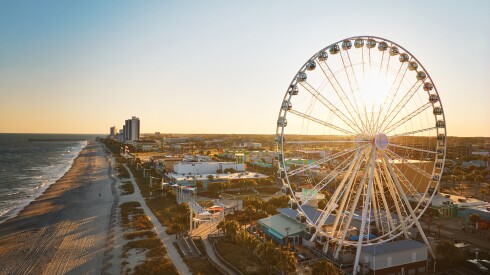For the past seven years, I have roamed the world working as a freelance photographer and running photo trips in Asia. The secret to travel photography, I’ve learned, is getting up painfully early. The reward is silence, photos with clean backgrounds, and a glimpse of the destination’s real culture.
My experience has taught me that the early bird gets the photo, but I’ve also learned much more. Whether you’re shooting with a zoom lens or a wide angle, on an iPhone 6 or a DSLR, here are some important photography tips for beginners that will help you improve your skills before your next adventure.
1. Create strong composition
The quality of a photograph is directly related to the composition. With portrait photography, focus on filling the frame to only include essential elements and crop out distractions. Create depth of field, perspective, scale, and balance with the camera angle you choose. Use leading lines to guide the eye around the frame. If the composition isn’t quite right, wait for something to come into the frame and complete the image. With landscape photography, a subject—no matter how subtle—can add contrast and strengthen your photo’s composition.
2. Search for clean backgrounds
Let’s be honest: Nobody looks good with a tree branch sticking out of the side of their head. Power lines, trees, and street lamps are notorious for sabotaging even the best of photos. The easiest way to improve your photography is to avoid distracting background elements by changing your position or moving your subject. Shooting from a lower angle and using a wide aperture—in other words, shortening the depth of field—will help blur out and lessen any distractions. Exclude any bright colors from the image that draw attention away from the subject.
3. Chase flattering light
When you find a landscape you want to photograph, return to the location multiple times throughout the day to document the changing light (if possible). Pay close attention to the quality and direction of both natural and artificial light. Haze, mist, and fog act as natural filters, which can mute colors and reduce contrast in your image. To determine the sun’s direction and type of shadows that will appear in your photograph, hold your hand into the light. This allows you to choose your angle and position your subject appropriately according to the most flattering light. The best time of day for portrait photography is known as the “magic hour”—thirty minutes before and after sunrise or sunset, when light is softer and more dynamic. The best sunset photos are usually before or after a storm when clouds add a dramatic, contrasting effect to the sky.
4. Notice people and details
Photographing strangers is easier than most think. Simply start a conversation. People love to talk about themselves. Consider putting away your camera and ask to come back later to take a photograph. In unfamiliar cultures, research local customs and taboos. Learn the basic words for “hello” and “thank you.” If you want to take a photo, point to your camera, smile and give a thumbs up sign. Their reaction will be your answer. Remember: If someone says no, they are saying no to the camera and not to you. Don’t take it personally. For portraits, focus on the eyes and other interesting features. Anticipate behavior and include details that reveal insight about your subject’s character.
5. Shoot from the hip
My favorite thing to do when I travel is to wander the streets with my camera and capture candid shots of everyday life—children walking to school, a fruit vendor stacking mangos, random street domino games. Though I still shoot the famous spots in destinations I visit, I was trained as a photojournalist to seek out the fascinating parts of daily life. Street photography is a method of understanding and documenting culture. It’s based on instinct and preparation: When you see a moment, you must react quickly to capture it before it disappears.
Shooting from the hip is a great way to change the perspective of a photo. I simply keep my camera at my side with the exposure set on manual mode to compensate ambient light with my shutter speed set to at least 1/250. With an iPhone, it’s very simple: I open my camera app, hold my iPhone horizontally at hip level and use my thumb to press the volume up button, which acts as a shutter release on all iPhones. I also pause for a second when I take an image to make sure the camera has time to focus.
Above all, the most important rule of travel photography is to practice persistence and patience. Have fun, be creative, and enjoy your travels!
Anna Mazurek is a travel photographer and writer based in Austin, Texas. Follow her adventures and travel advice at TravellikeAnna.com and Instagram.








